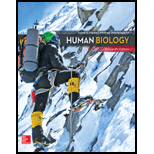
Human Biology
16th Edition
ISBN: 9781260482799
Author: Mader, Sylvia
Publisher: MCGRAW-HILL HIGHER EDUCATION
expand_more
expand_more
format_list_bulleted
Concept explainers
Question
Chapter 12.5, Problem 3CYP
Summary Introduction
To analyze:
The role of skeletal system for calcium homeostasis.
Introduction:
Calcium homeostasis is the process that maintains the calcium level in the bones. Thelevel of calcium is maintained by parathyroid hormones. The reabsorptions of bone by osteoclasts, release calcium ions into the blood and assists to regulate the calcium homeostasis.
Expert Solution & Answer
Want to see the full answer?
Check out a sample textbook solution
Students have asked these similar questions
What is the structure and function of Eukaryotic cells, including their organelles? How are Eukaryotic cells different than Prokaryotic cells, in terms of evolution which form of the cell might have came first? How do Eukaryotic cells become malignant (cancerous)?
What are the roles of DNA and proteins inside of the cell? What are the building blocks or molecular components of the DNA and proteins? How are proteins produced within the cell? What connection is there between DNA, proteins, and the cell cycle? What is the relationship between DNA, proteins, and Cancer?
Why cells go through various types of cell division and how eukaryotic cells control cell growth through the cell cycle control system?
Chapter 12 Solutions
Human Biology
Ch. 12.1 - State the functions of the skeletal system.Ch. 12.1 - Prob. 2LOCh. 12.1 - Prob. 3LOCh. 12.1 - Prob. 1CYPCh. 12.1 - Summarize the structure of a long bone by...Ch. 12.1 - Prob. 3CYPCh. 12.2 - Identify the bones of the skull, hyoid, vertebral...Ch. 12.2 - Prob. 2LOCh. 12.2 - Explain the function of the sinuses and...Ch. 12.2 - Prob. 1CYP
Ch. 12.2 - Identify the bones of the cranium and face, and...Ch. 12.2 - Prob. 3CYPCh. 12.3 - Prob. 1LOCh. 12.3 - Prob. 2LOCh. 12.3 - List the bones of the pectoral girdle and the...Ch. 12.3 - List the bones of the pelvic girdle and the lower...Ch. 12.3 - Prob. 3CYPCh. 12.4 - Prob. 1LOCh. 12.4 - Prob. 2LOCh. 12.4 - Prob. 3LOCh. 12.4 - List the three major types of joints.Ch. 12.4 - Prob. 2CYPCh. 12.4 - Describe the different movements of synovial...Ch. 12.5 - Prob. 1LOCh. 12.5 - Prob. 2LOCh. 12.5 - Prob. 3LOCh. 12.5 - Why do you think long bones are most often found...Ch. 12.5 - Prob. 1.2BTSCh. 12.5 - Prob. 2.1BTSCh. 12.5 - Prob. 2.2BTSCh. 12.5 - Prob. 1BTHCh. 12.5 - Prob. 2BTHCh. 12.5 - Prob. 1CYPCh. 12.5 - Summarize the stages in the repair of bone.Ch. 12.5 - Prob. 3CYPCh. 12 - Prob. 1ACh. 12 - Prob. 2ACh. 12 - Prob. 3ACh. 12 - Prob. 4ACh. 12 - Prob. 5ACh. 12 - Prob. 6ACh. 12 - Prob. 7ACh. 12 - Prob. 8ACh. 12 - Prob. 9ACh. 12 - Prob. 10ACh. 12 - Prob. 11ACh. 12 - Prob. 12ACh. 12 - Prob. 1TCCh. 12 - Prob. 2TCCh. 12 - 3. Why do the broken bones of older people take...Ch. 12 - Prob. 4TCCh. 12 - Prob. 5TCCh. 12 - Prob. 6TCCh. 12 - Prob. 7TC
Knowledge Booster
Learn more about
Need a deep-dive on the concept behind this application? Look no further. Learn more about this topic, biology and related others by exploring similar questions and additional content below.Similar questions
- In one paragraph show how atoms and they're structure are related to the structure of dna and proteins. Talk about what atoms are. what they're made of, why chemical bonding is important to DNA?arrow_forwardWhat are the structure and properties of atoms and chemical bonds (especially how they relate to DNA and proteins).arrow_forwardThe Sentinel Cell: Nature’s Answer to Cancer?arrow_forward
- Molecular Biology Question You are working to characterize a novel protein in mice. Analysis shows that high levels of the primary transcript that codes for this protein are found in tissue from the brain, muscle, liver, and pancreas. However, an antibody that recognizes the C-terminal portion of the protein indicates that the protein is present in brain, muscle, and liver, but not in the pancreas. What is the most likely explanation for this result?arrow_forwardMolecular Biology Explain/discuss how “slow stop” and “quick/fast stop” mutants wereused to identify different protein involved in DNA replication in E. coli.arrow_forwardMolecular Biology Question A gene that codes for a protein was removed from a eukaryotic cell and inserted into a prokaryotic cell. Although the gene was successfully transcribed and translated, it produced a different protein than it produced in the eukaryotic cell. What is the most likely explanation?arrow_forward
- Molecular Biology LIST three characteristics of origins of replicationarrow_forwardMolecular Biology Question Please help. Thank you For E coli DNA polymerase III, give the structure and function of the b-clamp sub-complex. Describe how the structure of this sub-complex is important for it’s function.arrow_forwardMolecular Biology LIST three characteristics of DNA Polymerasesarrow_forward
arrow_back_ios
SEE MORE QUESTIONS
arrow_forward_ios
Recommended textbooks for you
 Human Biology (MindTap Course List)BiologyISBN:9781305112100Author:Cecie Starr, Beverly McMillanPublisher:Cengage Learning
Human Biology (MindTap Course List)BiologyISBN:9781305112100Author:Cecie Starr, Beverly McMillanPublisher:Cengage Learning Human Physiology: From Cells to Systems (MindTap ...BiologyISBN:9781285866932Author:Lauralee SherwoodPublisher:Cengage Learning
Human Physiology: From Cells to Systems (MindTap ...BiologyISBN:9781285866932Author:Lauralee SherwoodPublisher:Cengage Learning Comprehensive Medical Assisting: Administrative a...NursingISBN:9781305964792Author:Wilburta Q. Lindh, Carol D. Tamparo, Barbara M. Dahl, Julie Morris, Cindy CorreaPublisher:Cengage Learning
Comprehensive Medical Assisting: Administrative a...NursingISBN:9781305964792Author:Wilburta Q. Lindh, Carol D. Tamparo, Barbara M. Dahl, Julie Morris, Cindy CorreaPublisher:Cengage Learning

Human Biology (MindTap Course List)
Biology
ISBN:9781305112100
Author:Cecie Starr, Beverly McMillan
Publisher:Cengage Learning

Human Physiology: From Cells to Systems (MindTap ...
Biology
ISBN:9781285866932
Author:Lauralee Sherwood
Publisher:Cengage Learning

Comprehensive Medical Assisting: Administrative a...
Nursing
ISBN:9781305964792
Author:Wilburta Q. Lindh, Carol D. Tamparo, Barbara M. Dahl, Julie Morris, Cindy Correa
Publisher:Cengage Learning



What is Homeostasis? | Physiology | Biology | FuseSchool; Author: FuseSchool - Global Education;https://www.youtube.com/watch?v=quQr6X1Q58I;License: CC-BY